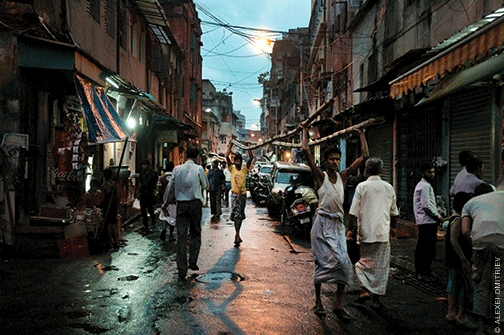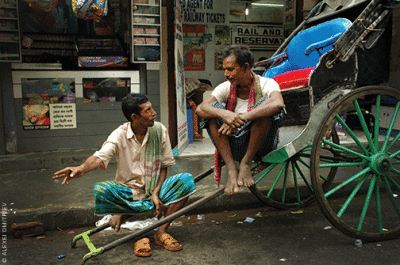
Finding braininess and beatitude in the City of Joy.
By Alexei Dmitriev | The first thing that catches my eye is the rusted billboard frames. They are everywhere. Downtown they stick out from the wild vegetation overgrowing the rooftops of Raj-era buildings—which themselves are not abandoned, but excessively occupied. Shredded advertisements hang from the frames like white flags of surrender.
But what catches the eye and what stirs the soul are two different things, and nowhere is that truer than in the City of Joy.
Few places have endured as much negative publicity as Kolkata. It began in 1756, when an unknown number of British prisoners suffocated overnight in the Fort William dungeon, the infamous “black hole of Calcutta.” Later came the horrors of Partition, waves of refugees from East Pakistan, and years of local Communist governance that heaped new problems atop old ones. By the time Mother Teresa established the Missionaries of Charity in the city, Calcutta had, in the eyes of many, become as untouchable as the people the Albanian nun came to care for.
Perhaps that helps to explain why, in 2001, the colonial but historically opulent Calcutta name was given up—in favor of the accurately transliterated but colorless Kolkata. Were the city fathers thinking that by changing the name the city could jettison all the depressing associations and bump up its national ranking?
“This city is used to deprivation, and has learned to treat it as a virtue,” a descendant of Bengali nabobs told me, as rain dripped through the roof of his handsomely dilapidated mansion in the Shobhabazar neighborhood. “But thanks to Teresa we stopped being a city and became a metaphor.”

The bare-footed and sinewy leg power behind the metaphor had helped me reach that aristocratic abode: I was a passenger aboard a hand-pulled rickshaw. As if to confirm its disturbing image, Kolkata remains the only major city in India where thousands of men are still allowed to ply this hard trade. I gladly paid three times the standard fare because of the foot-high rainwater my skinny “driver” had to wade through.
Yet these rickshaw drivers—among the untold thousands of other villagers streaming into the city every year from Bihar and Orissa—somehow manage to eke out an existence without resorting to theft, or even, in many cases, begging. Kolkata is surprising both in its safety and in the upward aspirations of its least fortunate denizens. The poverty in its streets may not change, but the faces do. Those who lived under a tarp tied to a wall a few years ago have traded up for a corrugated iron roof and four cement walls.
“Poverty alone does not produce slums; there must be prospects of social mobility as well,” a guide named Manjit tells me on a dusk-hour expedition to a beautiful Ganga Aarti devotional ritual on the riverbank. “There is a lot of ambition in these alleys.” Manjit, who runs Calcutta Photo Tours, takes his clients to discover a picturesque side of the dispossessed.
Calcutta was India’s first capital, and arguably its grandest. As the three villages originally leased by the British East India Company grew into a proper city on the banks of the Hooghly River, the company built a thick local cushion for their administration by investing substantial money and thought into educating a prominent Bengali middle class. By the end of the 19th century, Calcutta was a cosmopolitan wonderland of museums, palaces, and botanical gardens—complete with a Chinatown, an Armenian quarter (Armenians having been the first Europeans here), and a Portuguese church facing a synagogue across the street. The educated elites of West and East co-habited here quite amicably. Cultural life was thriving; in the beginning of the 20th century Calcutta had more literary magazines, cinemas, and concert halls than any other city in Asia.
Had Bengali intellectuals not gotten carried away with nationalist fervor, the British might not have punished them by relocating the capital to Delhi in 1912. But even that rebuke wasn’t enough to stop Calcutta’s creative spirit in its tracks. The city that gave the world Sri Vivekananda and Rabindranath Tagore in the 19th century would go on to produce the likes of Amartya Sen and Satyajit Ray in the 20th.
I came to Kolkata looking for the romantic India of my traveling twenties and found a place largely unchanged since before I was born. The overlapping imprints of different eras added to the city’s astonishing magnetism. Wandering through its streets brought to mind a courtesan beyond her prime whose juicy tattoos diverted attention from her declining health and occasionally poor hygiene. But I would not have come here for the India of call-centers, IT gurus, and high-end shopping malls.
Neither, it would seem, would most of the Kolkatans I befriended.
“Bengalis always believed that their purpose was to search for the refined things in life while others were supposed to do the dirty work,” the latter-day nabob told me, as we sank into a conversation about Kolkatans’ penchant for dwelling in the past.
Tagore could fairly be called the patron saint of this high-minded attitude. Bengalis’ reverence for the Nobel-winning poet and musician is total. You may get away with insulting the god of your choosing in any of Kolkata’s streets, but there’s a fair chance of getting slugged if you show disrespect to Tagore. His legacy is two-fold: not only did he propel Bengal into the world, he also engendered generations of poets anxious to get out of his shadow.
Their quest for refinement endures in the endemic pastime of adda baj: eclectic discussions about everything and nothing in particular, sometimes planned, often spontaneous, and seemingly always in progress at the historic Indian Coffee House at College Square.
Situated within spitting distance of four of the country’s oldest colleges, which were all established in the early to mid 1800s, the Coffee House at College Square is ground zero for the Kolkata intelligentsia—and any number of amorous couples hoping that the aura of this shabby but storied place will work some romantic magic.
“Once it was said that to be an intellectual in this chaotic city,” Ritobroto, a local student, told me, “you should read the dust jacket of Grundrisse, follow Derrida at some point in your youth, and spend six hours daily creating thunderstorms over cigarettes, coffee, and tea at the Indian Coffee House.”
When I asked of a group of Rito’s friends whether the small talk we were having about Indian mysticism would qualify as adda, the topic of mysticism was dropped. I had inadvertently triggered a full-blown adda on what constitutes an adda. A conversation that had been sprinkled with Tagore quotes shifted to non-Indian mystics, and presently, lo and behold, someone cited Dostoyevsky. Having learned of my provenance, one girl pronounced: “Bengalis and Russians are quite alike. Your literary hero Oblomov is a quintessential Bengali.”
“I’ll take 90 million Oblomovs over 90 million Raskolnikovs any time,” quipped another well-read Kolkatan, and the adda entered a new round.
The rest of India does its part to perpetuate the Bengalis’ claim of intellectual supremacy. “What Bengal thinks today,” one adage goes, “India thinks tomorrow.” But Indians also like to make fun of Bengalis’ reputation for laziness and inability to work together. “A pot with Bengali crabs does not need a lid,” goes another saying, “because the moment one of them makes it to the edge, the others will pull it down.”
Yet once a year even the most idle and garrulous Bengali turns into an energetic member of society. This metamorphosis happens during Durga Puja, the scope and importance of which overshadows Christmas in the West. Beginning months in advance, neighborhood leaders engage craftsmen to sculpt the most spectacular icons of the mother-goddess—the destroyer of evil and protector of prosperity—while carpenters build ever more elaborate pavilions, calledpandals, to house them. When the holiday arrives, thousands of Kolkatans throng the streets, jamming traffic in all directions as they pandal-hop around the city to find out which neighborhoods have risen most expensively and ornately to the challenge.
The sculptures incorporate straw and clay taken from the Hooghly River, as well as dust from thresholds of brothels in the red-light district—which, I was told, has a very high concentration of the virtues that men leave behind before entering the abode of sin. Finally, thousands of 10-armed Durgas descend on Kolkata. The goddess is depicted astride a lion, surrounded by her children as she beheads the demon Mahisha. I joined the crowds flowing from a psychedelically illuminated pandal, upon which Durga sat in a palace completely made of jute, to another one decorated with unearthly plastic flowers. A group of dakhi drummers motioned to me to join them. When I attempted to excuse myself as insufficiently integrated into Hindu ways, one replied: “So what? We are Muslims! We were just hired to play!”
The final day of the holiday challenges Kolkata’s already chaotic traffic to the fullest as thousands of trucks take Durga sculptures to be submerged in the Hooghly. When a truck near me gets stuck in the inevitable jam, people jump out of the back to dance in the street and cry out, “Bhalo thakben!” Be happy! The heavy sculptures are hauled by hand for the last few hundred yards, borne aloft by carriers who wobble with stomachs full of toddy. It’s a sight to catch the eye and soul alike. Dozens of shouting carriers with mad eyes pop the huge sculptures upright and then lower them into the water. In the river men on boats push the thick soup of heads, tiaras, and garlands away from the bank to make space for new divine arrivals.
This grand outburst of faith and civic camaraderie spares neither effort nor cost. It is unimaginable how much money that might be put to more pragmatic uses floats each year into the Bay of Bengal. But as much as bread—and perhaps more than many public amenities—Kolkatans need these few days of joy. And the celebrants begin to long for them again the next morning, when they come to the river to brush their teeth with the holy water that received their goddess.
Alexei Dmitriev G’88 is a documentary filmmaker in Potomac, Maryland.

